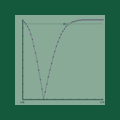|
||||||||||||||||||||||||||||||||||||||||||||||||||||||||||||||||||||||||||||||||||||||||||||||||||||||||||||||||||||||||
|
||||||||||||||||||||||||||||||||||||||||||||||||||||||||||||||||||||||||||||||||||||||||||||||||||||||||||||||||||||||||
| Maximum-likelihood |
|
|||||||||||||||||||||||||||||||||||||||||||||||||||||||||||||||||||||||||||||||||||||||||||||||||||||||||||||||||||||||
|
Most statistical models drawing conclusions from data utilize the principle of maximum-likelihood as their basis for statistical inference. Though it is often not explicitly stated in text books, familiar statistical models such as simple linear regression are formulated using the principle of maximum-likelihood. The premise of maximum-likelihood estimation is that the parameter estimates, and their uncertainties, obtained from data drawn from a population, facilitate inference about the point 'true' values of those parameters in that population. Conceptually, the goal of maximum-likelihood estimation is quite simple, the idea being to identify a deterministic model that renders your observed data most likely to have been generated by that model. That is, the distribution of your observed data should depart from that deterministic model in a manner that mimics the error specification for your model. This is particularly intuitive for basic models like simple linear regression where, in the absence of a statistical methodology, your temptation would be to draw a straight line through your observed data. Maximum-likelihood techniques formalize this intuition by using statistical theory to determine the location of that straight line. Under the assumption of independence of observed data points, the principle of maximum-likelihood is applied by simply multiplying the probabilities (or probability densities) of each individual, independent data point, given the deterministic model structure and parameter estimates. However, this is a conditional probability, which means that an explicit statement of probability requires that we know the probability of the model we are using. Since there are an infinite number of potential models, we cannot provide an explicit statement of probability of our particular model. Thus we can only rank model probabilities so we refer to our statistical goal as finding the most likely model, rather than the most probable, model. Typically, to avoid dealing with extremely small numbers that arise by sequentially multiplying values less than unity (the probabilities), we choose to sum the negative natural logarithm of those probabilities. This convenience also comes with satisfying statistical properties for drawing uncertainty inferences about parameter estimates. These properties help explain the almost universal use of the negative ln-likelihood as a basis for statistical inference. For example, the familiar minimum sum-of-squares parameter estimates associated with regression analysis and analysis of variance are maximum-likelihood estimates because the sum-of-squares calculation is derived from the negative ln-likelihood of a Gaussian (normal) distribution of errors.
|
||||||||||||||||||||||||||||||||||||||||||||||||||||||||||||||||||||||||||||||||||||||||||||||||||||||||||||||||||||||||
